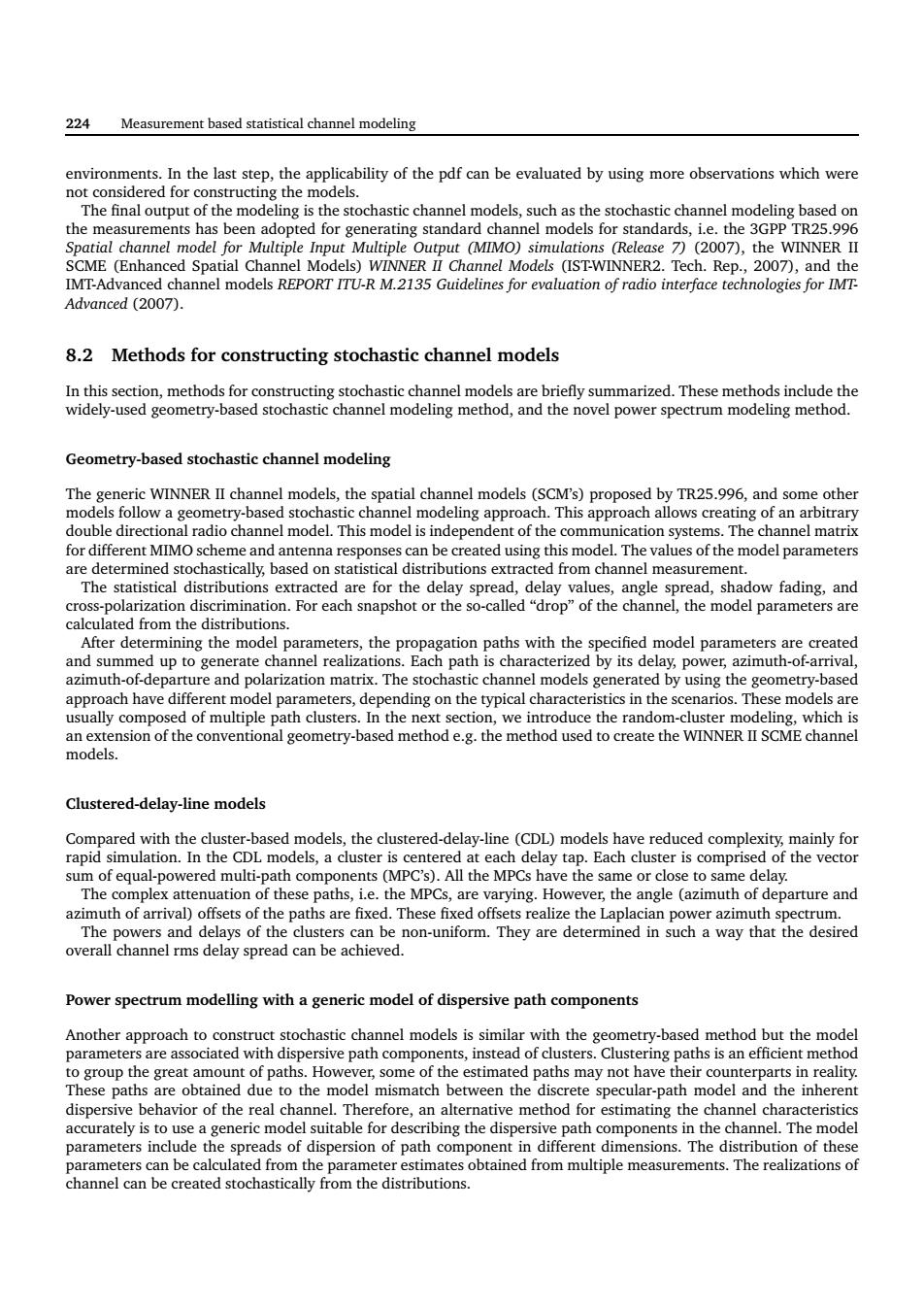正在加载图片...

224 Measurement based statistical channel modeling licability of the pdf can be evaluated by using more observations which were sicchannel modeling basedo Output (MIMO)simulations (Release )(2007),the WINNER ER2. 7),and the e Advanced (2007). 8.2 Methods for constructing stochastic channel models In this section.methods for constructing stochastic channel models are briefly summarized.These methods include the widely-used geometry-based stochastic channel modeling method,and the novel power spectrum modeling method. Geometry-based stochastic channel modeling ageometry-based stochastic han ial cha nel me odeling a creat e directi radio chan el model.This model is independent of the cation syster The low fading,and CctiBedihomohedistbutios. arameters are d model param rare created azimuth-ofdeparture and polarization matrix.The stochastic channel models ge red by using the ge omet abased l parameters,dep e models ar eom try-based methodeg the method used to create the WINNER ISCME channe models. Clustered-delay-line models CDI)models ts (M All the MPCs h ve the sameor e to sa elay e and The powers and of the lay spread c They re detemined the Power spectrum modelling with a generic model of dispersive path components aoe即ad erCurerin Path器d8e. paramet are associated v ts,inst dispersi rsion of path com of these parametersc imates obtained from multiple measurements.The realizations of 224 Measurement based statistical channel modeling environments. In the last step, the applicability of the pdf can be evaluated by using more observations which were not considered for constructing the models. The final output of the modeling is the stochastic channel models, such as the stochastic channel modeling based on the measurements has been adopted for generating standard channel models for standards, i.e. the 3GPP TR25.996 Spatial channel model for Multiple Input Multiple Output (MIMO) simulations (Release 7) (2007), the WINNER II SCME (Enhanced Spatial Channel Models) WINNER II Channel Models (IST-WINNER2. Tech. Rep., 2007), and the IMT-Advanced channel models REPORT ITU-R M.2135 Guidelines for evaluation of radio interface technologies for IMTAdvanced (2007). 8.2 Methods for constructing stochastic channel models In this section, methods for constructing stochastic channel models are briefly summarized. These methods include the widely-used geometry-based stochastic channel modeling method, and the novel power spectrum modeling method. Geometry-based stochastic channel modeling The generic WINNER II channel models, the spatial channel models (SCM’s) proposed by TR25.996, and some other models follow a geometry-based stochastic channel modeling approach. This approach allows creating of an arbitrary double directional radio channel model. This model is independent of the communication systems. The channel matrix for different MIMO scheme and antenna responses can be created using this model. The values of the model parameters are determined stochastically, based on statistical distributions extracted from channel measurement. The statistical distributions extracted are for the delay spread, delay values, angle spread, shadow fading, and cross-polarization discrimination. For each snapshot or the so-called “drop” of the channel, the model parameters are calculated from the distributions. After determining the model parameters, the propagation paths with the specified model parameters are created and summed up to generate channel realizations. Each path is characterized by its delay, power, azimuth-of-arrival, azimuth-of-departure and polarization matrix. The stochastic channel models generated by using the geometry-based approach have different model parameters, depending on the typical characteristics in the scenarios. These models are usually composed of multiple path clusters. In the next section, we introduce the random-cluster modeling, which is an extension of the conventional geometry-based method e.g. the method used to create the WINNER II SCME channel models. Clustered-delay-line models Compared with the cluster-based models, the clustered-delay-line (CDL) models have reduced complexity, mainly for rapid simulation. In the CDL models, a cluster is centered at each delay tap. Each cluster is comprised of the vector sum of equal-powered multi-path components (MPC’s). All the MPCs have the same or close to same delay. The complex attenuation of these paths, i.e. the MPCs, are varying. However, the angle (azimuth of departure and azimuth of arrival) offsets of the paths are fixed. These fixed offsets realize the Laplacian power azimuth spectrum. The powers and delays of the clusters can be non-uniform. They are determined in such a way that the desired overall channel rms delay spread can be achieved. Power spectrum modelling with a generic model of dispersive path components Another approach to construct stochastic channel models is similar with the geometry-based method but the model parameters are associated with dispersive path components, instead of clusters. Clustering paths is an efficient method to group the great amount of paths. However, some of the estimated paths may not have their counterparts in reality. These paths are obtained due to the model mismatch between the discrete specular-path model and the inherent dispersive behavior of the real channel. Therefore, an alternative method for estimating the channel characteristics accurately is to use a generic model suitable for describing the dispersive path components in the channel. The model parameters include the spreads of dispersion of path component in different dimensions. The distribution of these parameters can be calculated from the parameter estimates obtained from multiple measurements. The realizations of channel can be created stochastically from the distributions